Overview
For tech startup founders, navigating the complexities of branding can often feel overwhelming. The challenge lies in creating a strong brand presence that truly resonates with your audience. Without a clear narrative, visual identity, and defined brand values, it’s easy to feel lost in a competitive market. These elements are not just components; they are the foundation of trust and loyalty that your customers seek.
Imagine the impact of a cohesive brand identity that speaks to your audience's heart. When your brand values align with their expectations, you foster a deep connection that can transform casual customers into loyal advocates. A nurturing tone of voice, combined with thoughtful imagery guidelines, creates an inviting atmosphere that encourages engagement and builds community.
The solution lies in embracing these essential elements for your branding deck:
- A clear narrative
- Visual identity
- Brand values
- Tone of voice
- Imagery guidelines
- A compelling call to action
Together, they form a powerful toolkit that can support you in establishing a brand presence that not only stands out but also resonates deeply with your audience. By focusing on these aspects, you can navigate the challenges of the tech landscape with confidence, knowing that you have the tools to foster trust and enhance customer loyalty.
Introduction
In the fast-paced world of tech startups, establishing a compelling brand presence can often feel like navigating a labyrinth. Many founders find themselves overwhelmed, grappling with the complexities of creating an effective branding deck. It's important to recognize that a well-crafted branding deck is not just a collection of visuals and logos; it serves as the backbone of a company's identity, encapsulating its mission, values, and unique story. However, the struggle to create this essential tool can lead to missed opportunities and a diluted market presence, leaving founders feeling frustrated and uncertain.
But there is hope. Startups can transform their branding decks from mere presentations into powerful tools that foster recognition, loyalty, and authentic connections with their audience. By embracing this journey, founders can not only enhance their brand presence but also cultivate a sense of community and support around their vision. Let’s explore how you can navigate this process with confidence and clarity.
RNO1: Comprehensive Branding and Identity Services
In today's competitive landscape, many tech startup founders struggle with the challenge of establishing a strong brand presence through their branding deck. This problem can be overwhelming, as a lack of a clear branding deck often leads to confusion in the marketplace and missed opportunities to connect with potential customers. It’s crucial to understand that a branding deck represents more than just a logo; it embodies the purpose and values of a company, fostering personal relationships with customers. As marketing specialist Simon Mainwaring wisely notes, a label is defined by its purpose, which underscores the necessity of a well-defined branding deck strategy.
RNO1 recognizes the pain points that come with this journey. The implications of an ineffective branding deck can be significant, leaving founders feeling lost and their businesses struggling to stand out. However, there is hope. RNO1 provides a comprehensive range of branding deck services designed to nurture and support purpose-driven companies. From strategy development and logo design to comprehensive identity guidelines and Go-To-Market Strategy, these services come together to form a cohesive branding deck across various platforms.
Effective logo design, for instance, is pivotal in brand recognition, encapsulating the essence of a brand's identity. This strategic approach enhances visibility, fosters trust, and builds customer loyalty—key elements for driving business growth in the tech sector, which are highlighted in our branding deck. Remember, it takes 20 years to build a reputation and just five minutes to ruin it. This highlights the long-term importance of effective branding strategies, and RNO1 is here to assist you in developing a strong branding deck.
By leveraging RNO1's offerings, you can establish a robust branding deck that resonates with your target audience and distinguishes you in a crowded marketplace. Together, we can , ensuring that your company not only survives but thrives.
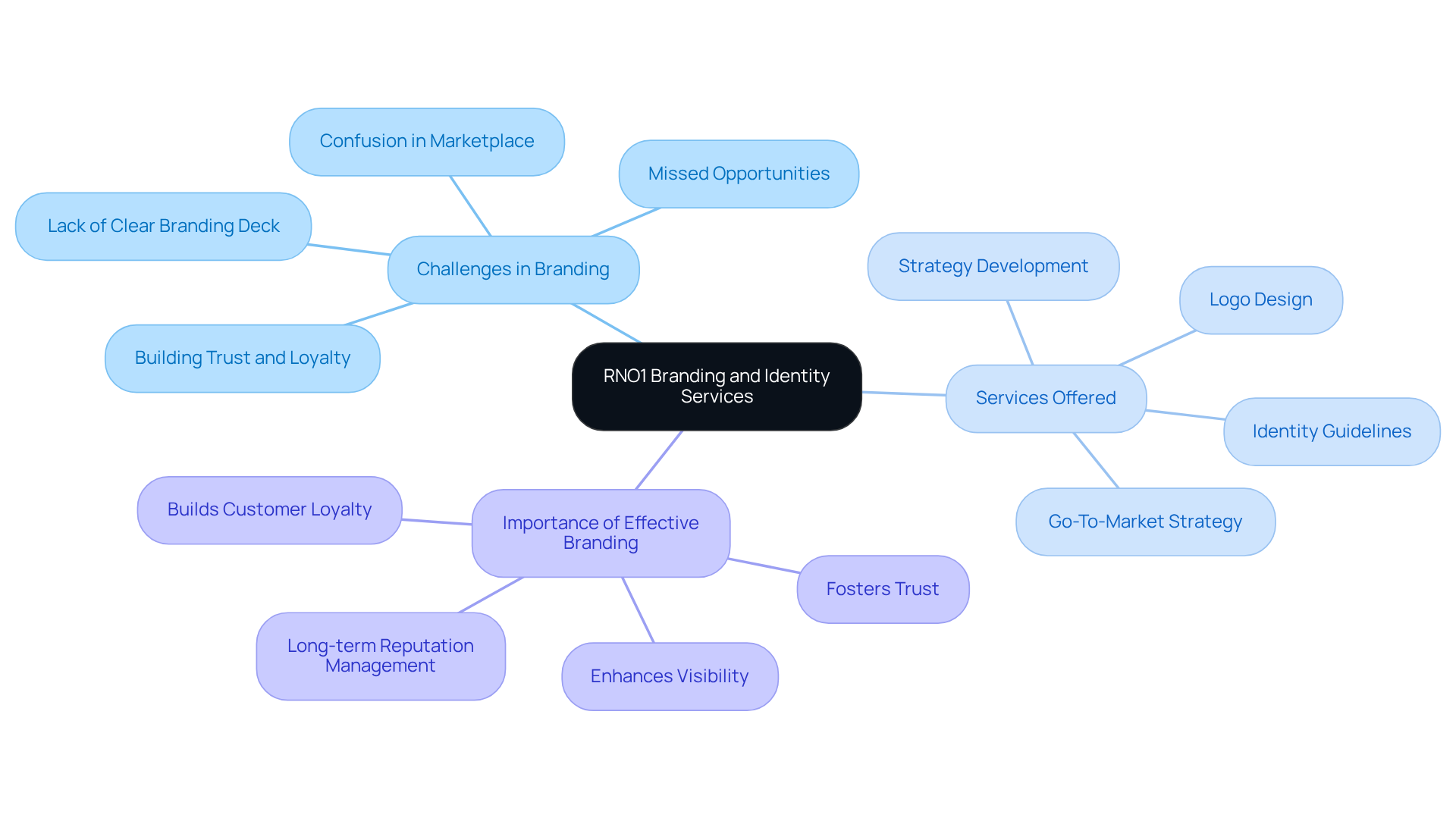
Brand Story: Crafting a Compelling Narrative
Creating an engaging company narrative is a vital step for tech startups striving to carve out a strong market presence. Many founders grapple with articulating their organization's mission, vision, and journey in a way that genuinely reflects their unique value proposition and resonates with the aspirations of their target audience. This challenge can feel overwhelming, especially when:
- 81% of consumers will need to trust a company before making a purchase, and
- 63% are more likely to buy from businesses they perceive as authentic.
A well-defined narrative not only captures attention but also fosters deeper connections with customers, encouraging them to become advocates for the brand's identity.
As trends evolve, it becomes essential for tech startups to harness the power of storytelling to differentiate themselves in a competitive landscape. They must ensure their narratives are engaging and consistent with the principles that matter to their customers. The strategic rebranding of Founder's Haven by RNO1 stands as a testament to this approach, empowering modern founders to enhance their digital presence through authentic storytelling.
Moreover, employing subscription models, like those offered by RNO1, can provide ongoing support for continuous narrative development. Aligning narratives with social causes can deepen connections with consumers, making them feel part of a larger mission. To implement effective storytelling strategies, tech startups should focus on:
- Authenticity
- Emotional engagement
- Alignment with their audience's values
By doing so, they can create a narrative that not only speaks to their mission but also nurtures a community of loyal supporters.
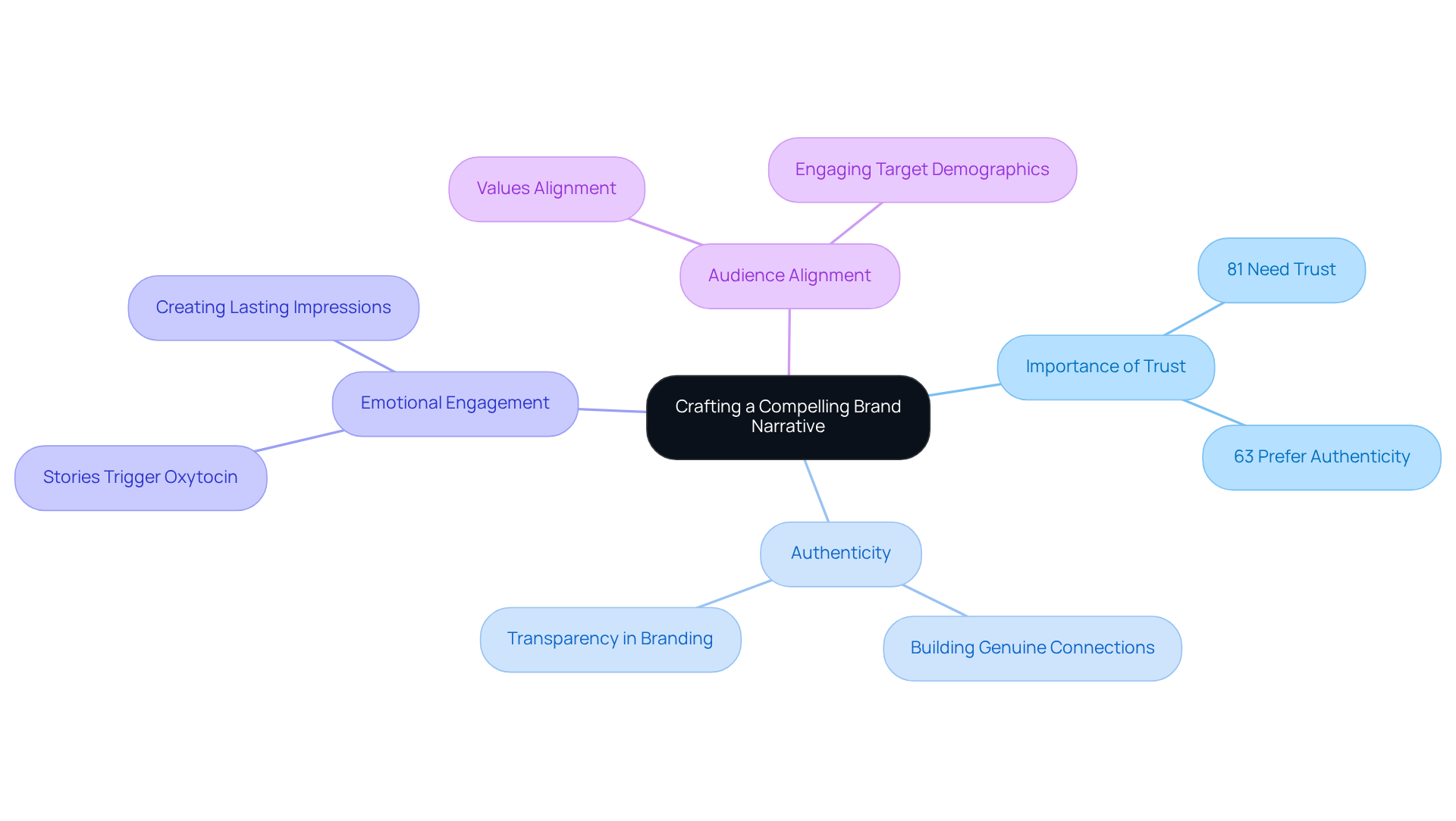
Visual Identity: Logo and Color Palette Guidelines
The branding deck, which encompasses the visual representation of a company through its logo and color scheme, serves as a foundational element for recognition and consistency. Many startup founders struggle with how to effectively utilize these elements in their branding deck across various platforms, which can lead to confusion and inconsistency. This lack of clarity not only hinders recognition but can also obscure the company's personality and values presented in the branding deck, making it harder to connect with customers.
At RNO1, we see every design choice as a strategic opportunity to enhance marketability through our branding deck and Return On Design & Digital (RODD) strategies, and we are here to support you in this journey.
For example, when Tom-Tech underwent its rebranding from Kovinoplastika Tomažič, it involved a thoughtful process that included careful planning and a clear timeline. The new logo and color scheme provided a contemporary visual identity while maintaining a connection to its predecessor through an updated monogram. This considerate approach to creating a branding deck for rebranding led to a significant increase in revenue and market presence, illustrating how a strategic visual representation can strengthen customer relationships and enhance overall recognition in the tech sector.
To develop or assess a suitable color palette, it's essential for companies to consider their target audience and ensure that the colors resonate with their principles and messaging. Engaging in surveys or focus groups can provide valuable feedback on color preferences, helping to ensure that your visual identity aligns with customer expectations and fosters engagement and loyalty.
We encourage you to share your experiences and thoughts, as together we can that truly reflects your company's essence.
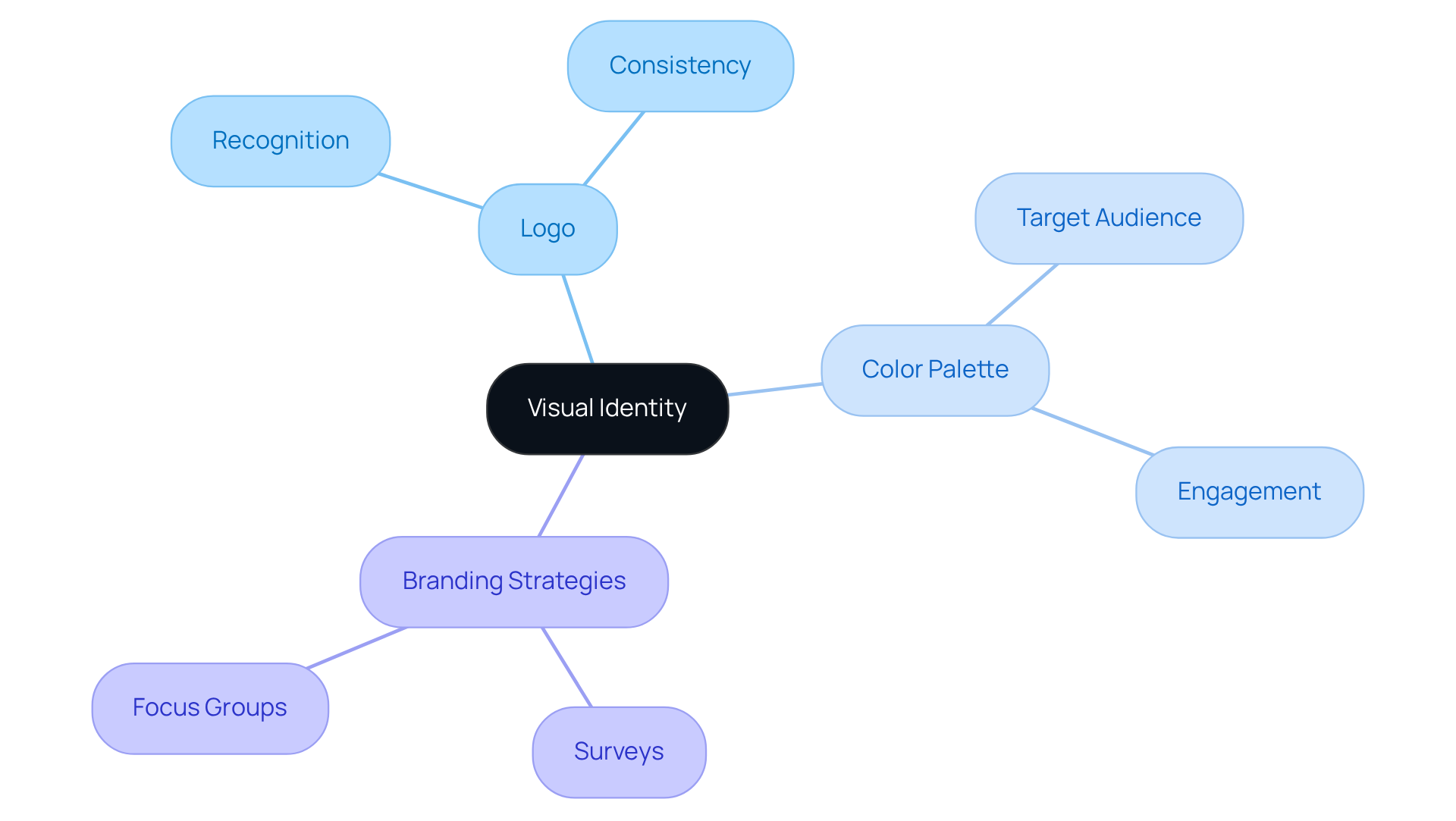
Brand Values: Establishing Core Principles
Defining essential principles is crucial for guiding a company's actions and decisions. These principles should truly reflect what the company stands for and resonate deeply with its intended audience, particularly in the technology industry. When companies articulate these principles clearly, they can among customers.
It's important to acknowledge that aligning company principles with those of their customers creates emotional connections that significantly enhance customer loyalty. This alignment not only fosters credibility but also ensures that messaging and actions consistently mirror the organization's identity.
Furthermore, authenticity requires companies to consistently align their actions with their stated principles, which is vital for building trust. In today's competitive marketplace, companies that demonstrate reliability and integrity through their core values are more likely to earn customer loyalty, as consumers increasingly seek authenticity and transparency in their interactions.
Moreover, creating a community around the company nurtures a sense of belonging, further strengthening customer loyalty.
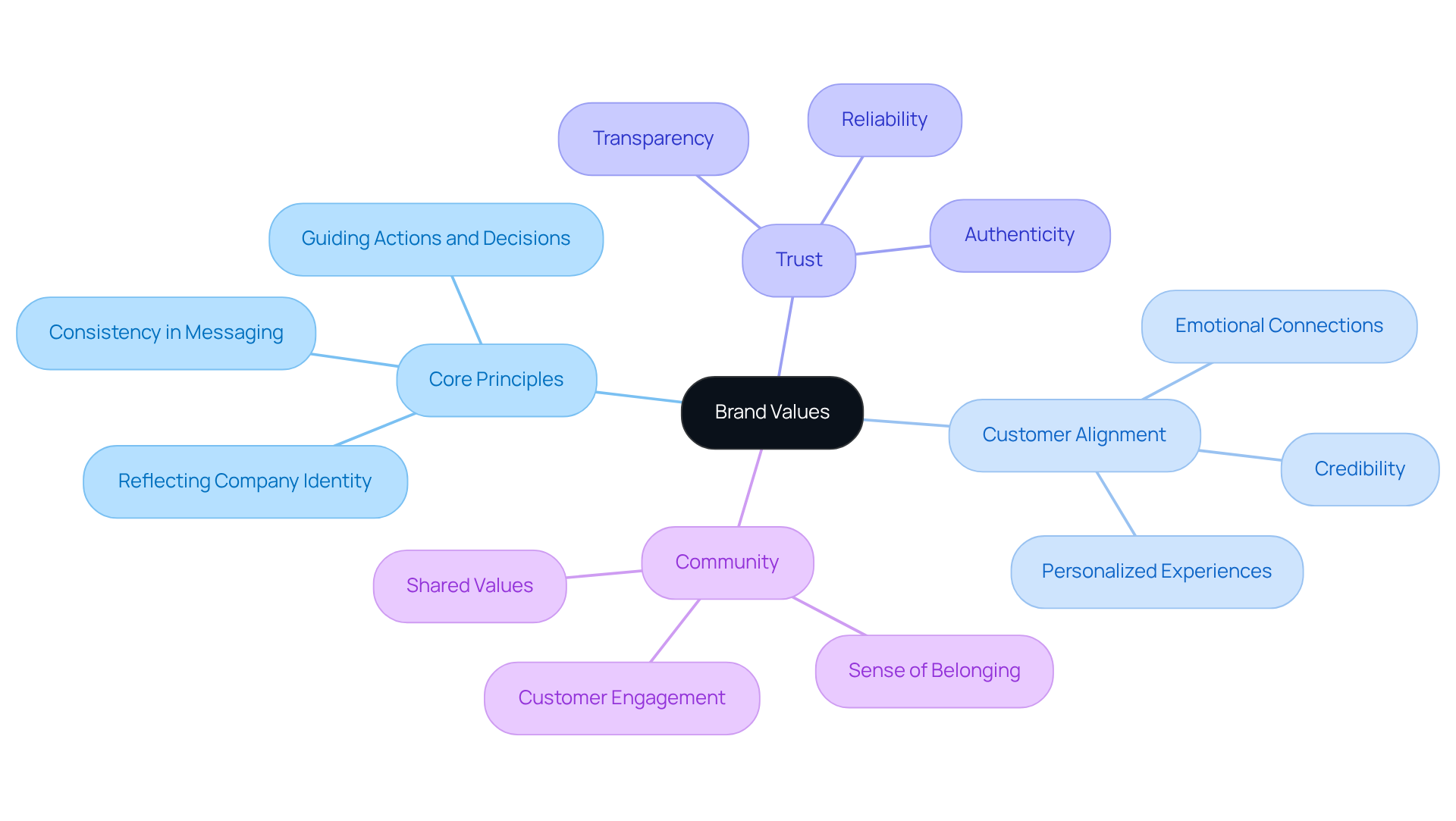
Tone of Voice: Defining Your Brand's Communication Style
Creating a company's tone of voice can feel overwhelming, yet it's essential for meaningful interactions with your audience. This encompasses not just the choice of words, but also the stylistic choices and the overall messaging strategy. A consistent tone of voice nurtures a recognizable personality and fosters deeper connections with customers, helping them understand your core values.
For instance, RNO1's strategic rebranding of Founder's Haven demonstrates how empowering contemporary founders through clear communication can enhance perception and drive digital success. Companies that maintain a coherent communication style often see a significant boost in how they are perceived by consumers, cultivating trust and loyalty.
Consistency in messaging is vital; it ensures that customers experience a cohesive journey across all touchpoints, reinforcing your company's presence and making it memorable. In today's competitive landscape, clear and engaging communication can truly set your company apart, driving customer engagement and connection.
Remember, you’re not just communicating; you’re .
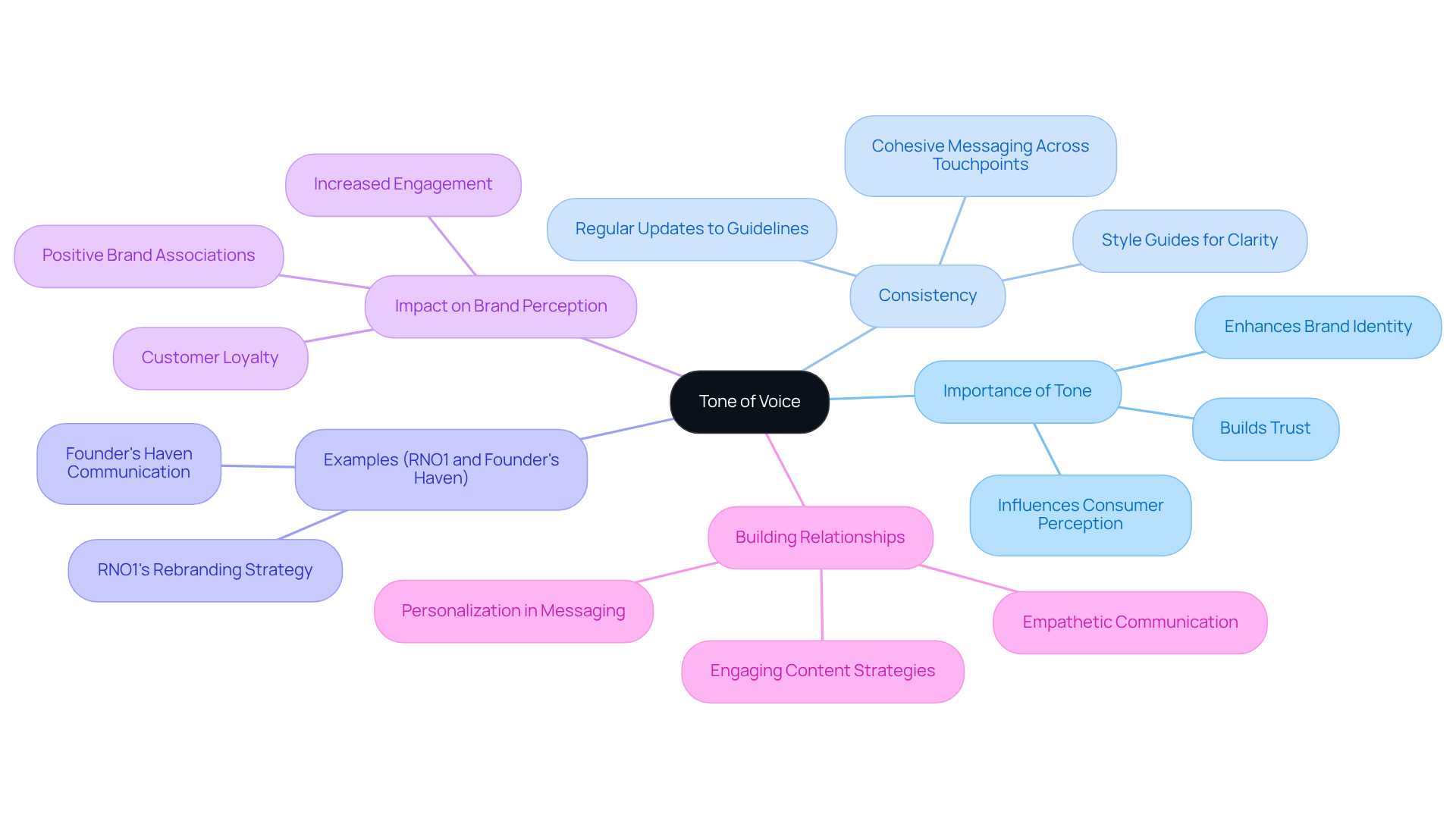
Imagery: Guidelines for Visual Content
Imagery guidelines present a significant challenge for many companies striving to define the visuals that resonate with their identity. When visuals such as photography styles, illustrations, and graphic elements are inconsistent, it can lead to a disconnect with audiences. This inconsistency not only dilutes the message and values but also hampers the potential for a deeper emotional connection.
It’s concerning to note that high-quality and relevant visuals are crucial; studies show that posts featuring images can generate a staggering 650% higher engagement rate. Moreover, visual content garners 94% more views and is 40 times more likely to be shared on social media than text alone. Companies that prioritize visual content often see a remarkable increase in recognition. For instance, color can enhance recall by up to 80%, and consumers are 81% more likely to remember a company’s color than its name.
By adhering to clear imagery guidelines outlined in their branding deck, companies can ensure their visual content aligns harmoniously with their messaging, ultimately enhancing their reputation and impact. It’s worth noting that more than half of initial impressions of companies are visual, underscoring the importance of maintaining consistent and high-quality imagery. Regularly reviewing and can help companies stay in sync with evolving identity and audience expectations.
Let’s embrace this journey together, ensuring that our visuals not only represent our brand but also foster genuine connections with those we aim to serve.
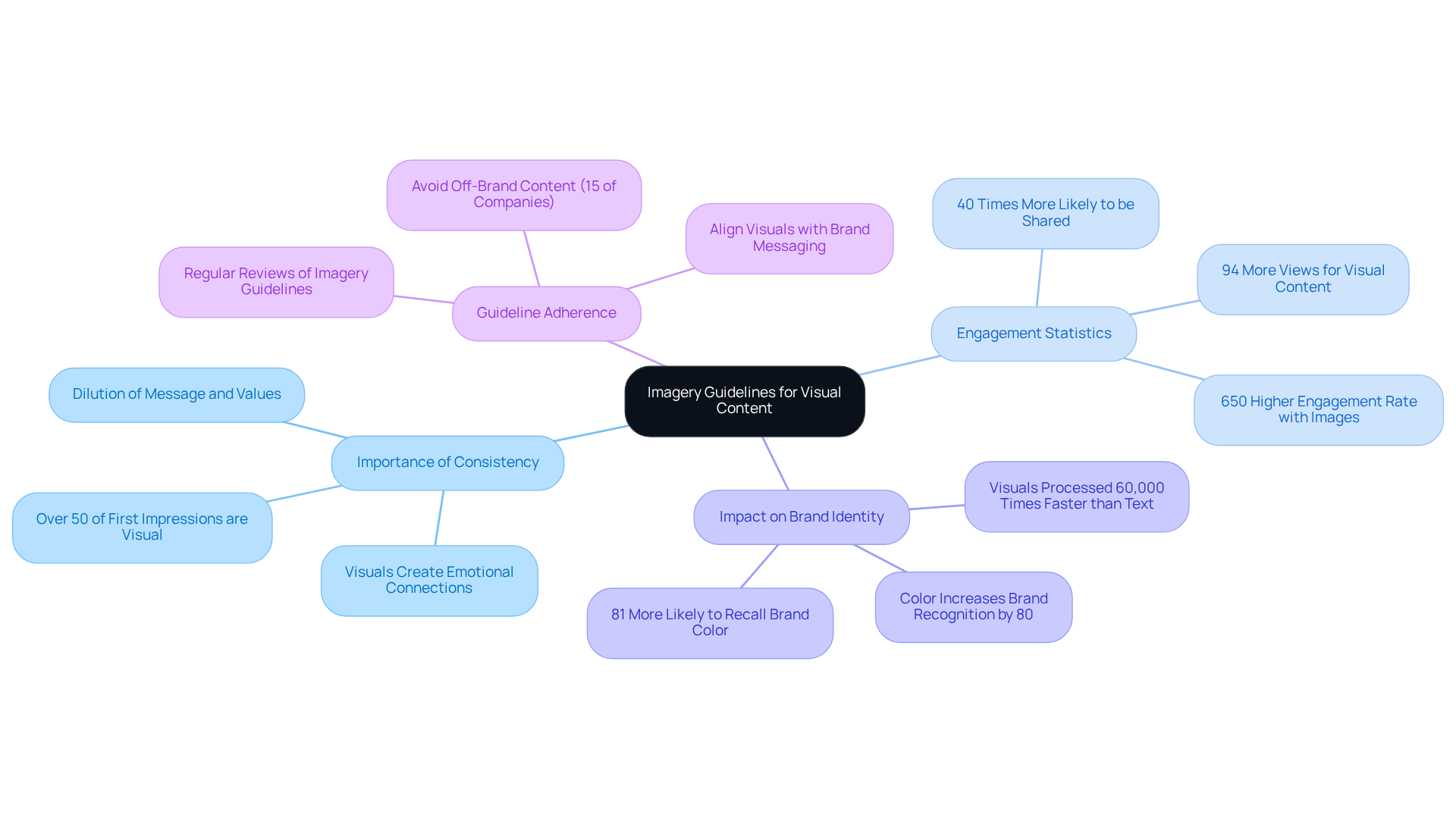
Case Studies: Successful Branding Deck Examples
Including case studies in a presentation can truly resonate with those navigating the complex landscape of marketing strategies. Many tech startup founders often grapple with the challenge of demonstrating effective growth, and it’s understandable to feel overwhelmed. RNO1 has partnered with innovative firms like Microsoft and Airbnb, showcasing how they’ve successfully promoted scalable growth and enhanced user experiences. These real-world examples serve not only as inspiration but also as a branding deck for companies eager to strengthen their identity.
By reflecting on the strategies that have brought success to others, startups can glean invaluable lessons and adapt these insights to their own marketing efforts. As Scott Bedbury wisely notes, a company's narrative is always evolving, and learning from the journeys of others can significantly enhance its connection with its target audience. Jeff Bezos emphasizes that a company’s reputation is shaped by what people say when it’s not in the spotlight, highlighting the importance of consistent marketing efforts.
Additionally, Howard Schultz points out that when individuals feel aligned with a company’s values, they are more likely to remain loyal to the brand. This underscores the necessity for startups to through thoughtful marketing strategies. By adopting this analytical approach, founders can gain a deeper understanding of what truly resonates with their audiences, ultimately leading to a more effective marketing strategy.
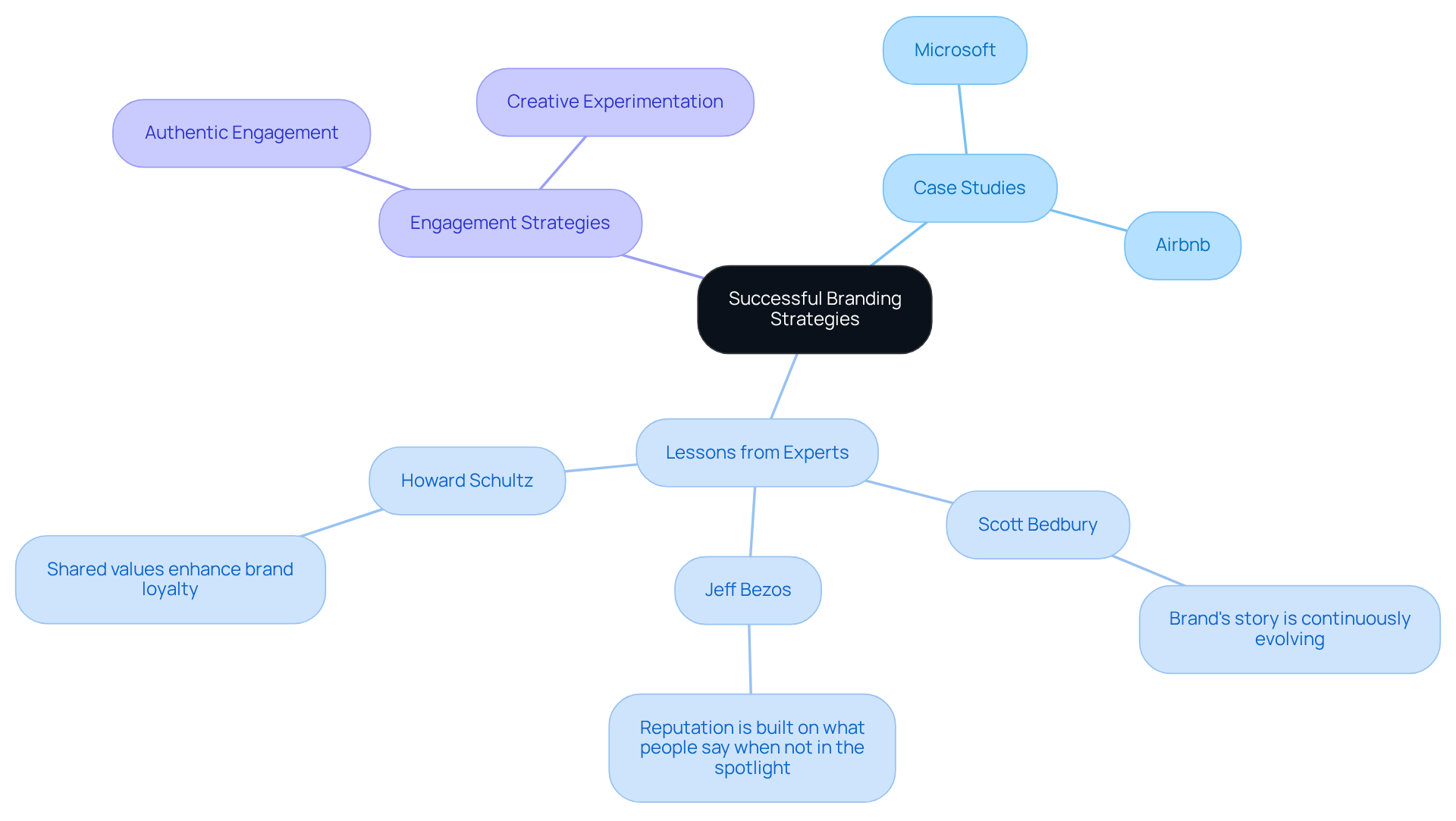
Digital Asset Management: Ensuring Brand Consistency
Digital asset management (DAM) is a crucial aspect for organizing and maintaining marketing materials like logos, images, and templates. Many tech startup founders find themselves overwhelmed by the sheer volume of assets they need to manage. This can lead to inconsistencies and confusion, which can hinder brand recognition and loyalty among target audiences.
At RNO1, we understand that a design-focused approach is vital in every aspect of brand identity. By implementing a robust DAM system, you can ensure that your assets remain consistent and up-to-date, significantly enhancing your connection with consumers. Consistent identity across all channels fosters trust and streamlines processes, allowing your team to quickly access the resources they need.
Looking ahead to 2025, the best practices for managing promotional materials will involve:
- Centralizing assets for easy access
- Ensuring adherence to guidelines
- Frequently refreshing content to reflect current market trends
Effective systems for organizing marketing materials leverage technology to enhance collaboration and productivity, ultimately resulting in a more unified identity that resonates with your audience. This organized approach to brand identity, as outlined in the branding deck, is essential for contemporary brands striving to thrive in a competitive landscape.
For tech startup founders, utilizing a DAM tool can provide immediate value by centralizing assets and enhancing team collaboration, all while ensuring that design remains a top priority in every interaction. We are here to support you on this journey, assisting you in .
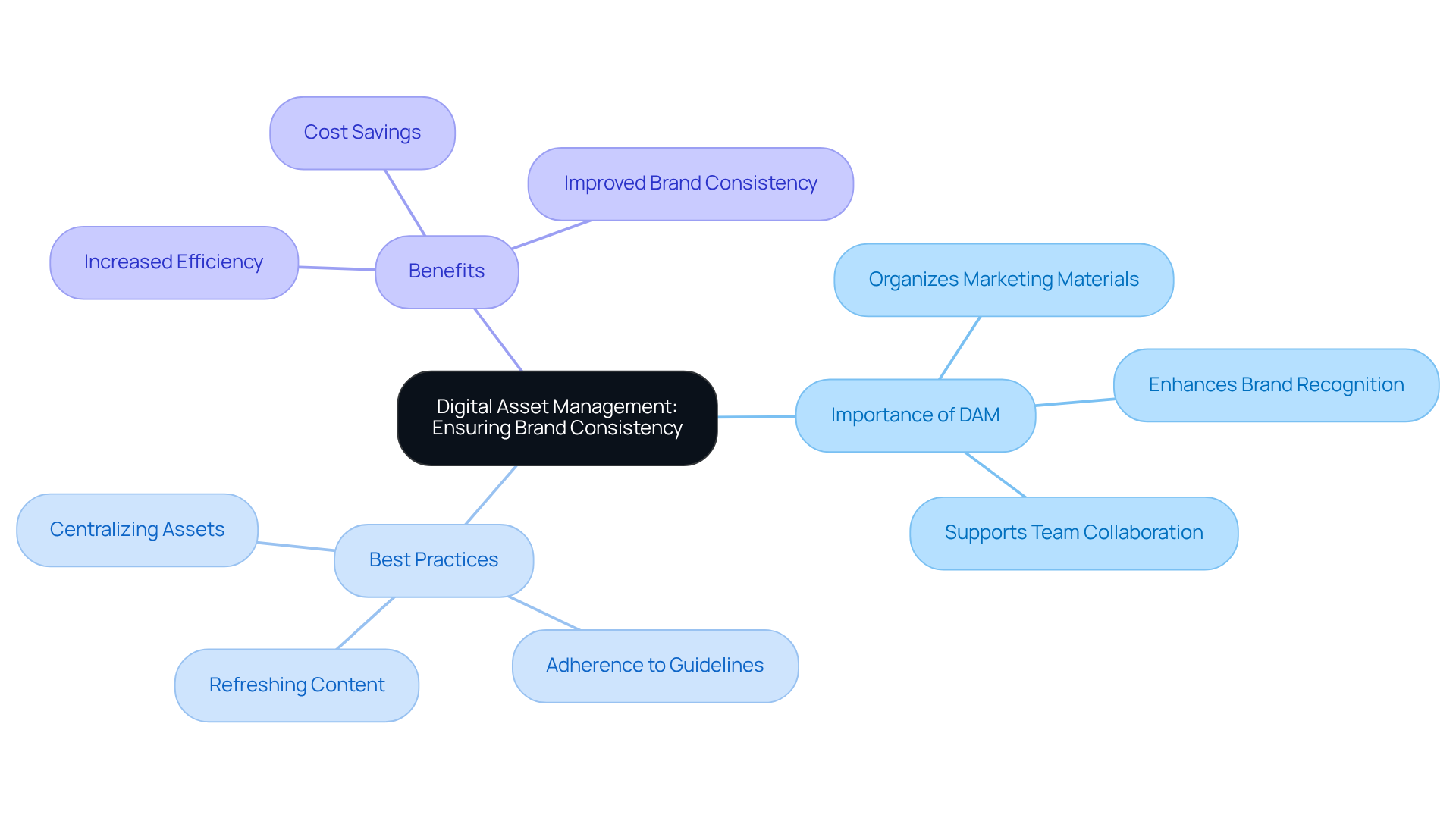
Call to Action: Guiding Stakeholders on Next Steps
In the realm of branding, a well-defined call to action (CTA) is essential for guiding stakeholders toward the next steps they should take. Many founders face the challenge of ensuring their stakeholders know how to engage effectively, whether that's exploring the company's website, connecting through social media, or participating in upcoming events. This uncertainty can leave stakeholders feeling disconnected.
However, by providing clear and actionable steps, you can significantly enhance their engagement. This not only propels your objectives forward but also fosters a sense of belonging and involvement among your stakeholders. Effective CTAs clarify expectations and nurture a sense of ownership, encouraging stakeholders to actively contribute to your brand's journey.
Adding a sense of urgency to your CTAs can lead to a remarkable 332% increase in conversion rates, while visually appealing CTAs can elevate click-through rates by 42%. As Julie Cottineau beautifully states, a branding deck represents your fundamental promise of whom you serve, how you make them feel, and what's different about how you deliver. This reinforces the in fulfilling that promise with compassion and clarity.
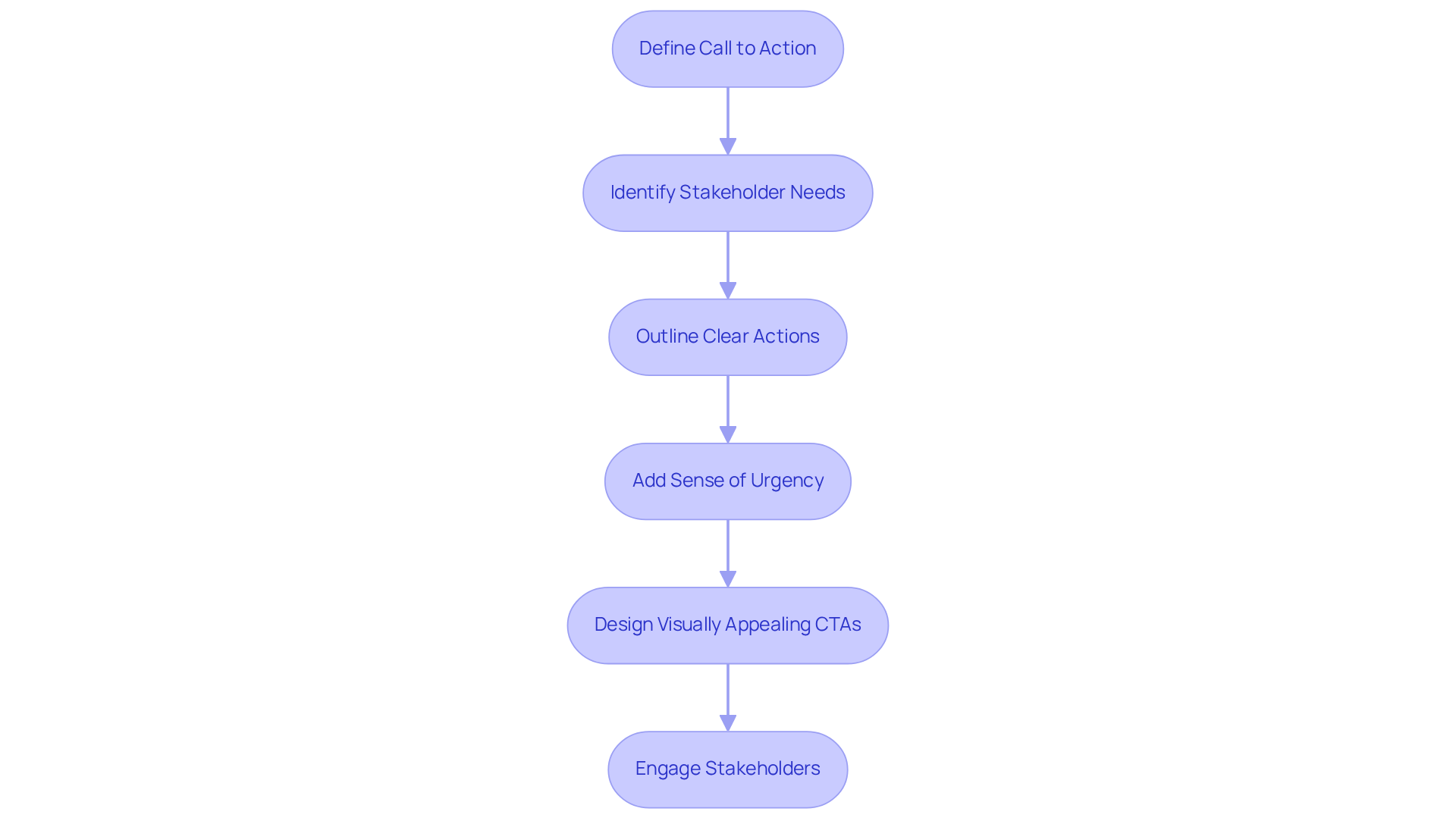
Conclusion
Crafting an effective branding deck can feel overwhelming for tech startups striving to carve out a unique identity in a bustling marketplace. It's a challenge that many face, and it’s important to recognize the emotional toll this can take. This article sheds light on the essential components of a successful branding strategy, highlighting how a cohesive narrative, strong visual identity, and clear communication can make a significant difference. A thoughtfully designed branding deck not only captures your company’s mission and values but also builds trust and loyalty among your consumers.
Key insights shared here emphasize the need for comprehensive branding services that cover everything from logo design to digital asset management. The power of storytelling in branding is profound; a compelling narrative speaks to the heart of your audience and fosters a sense of belonging. Moreover, sticking to visual identity guidelines and maintaining a consistent tone of voice are vital for effective communication and brand recognition.
The journey of building a powerful brand is not a sprint but a marathon, requiring ongoing commitment to authenticity and engagement. By embracing the insights and strategies discussed, tech startups can navigate the intricate world of branding with renewed confidence, ensuring that their message not only reaches but truly resonates with their audience. By integrating these essential elements, you empower yourself to create a branding deck that genuinely reflects your company’s essence, paving the way for sustainable growth and meaningful connections in the ever-evolving digital landscape.
Frequently Asked Questions
What is the importance of a branding deck for tech startups?
A branding deck is crucial for tech startups as it represents more than just a logo; it embodies the company's purpose and values, helping to establish a strong brand presence and connect with potential customers.
What services does RNO1 offer for branding decks?
RNO1 offers a comprehensive range of branding deck services, including strategy development, logo design, identity guidelines, and Go-To-Market Strategy, all aimed at supporting purpose-driven companies.
How does effective logo design impact brand recognition?
Effective logo design is pivotal in brand recognition as it encapsulates the essence of a brand's identity, enhancing visibility, fostering trust, and building customer loyalty, which are essential for business growth.
Why is storytelling important for tech startups?
Storytelling is important for tech startups because it helps articulate their mission, vision, and unique value proposition, fostering deeper connections with customers and encouraging them to become advocates for the brand.
What elements should tech startups focus on when developing their narratives?
Tech startups should focus on authenticity, emotional engagement, and alignment with their audience's values when developing their narratives to create a compelling story that resonates with customers.
How does visual identity contribute to a company's branding deck?
Visual identity, including logo and color palette, serves as a foundational element for recognition and consistency in a company's branding deck, helping to convey the company's personality and values clearly to customers.
What strategies can companies use to develop an effective color palette?
Companies can develop an effective color palette by considering their target audience and ensuring that the colors resonate with their principles and messaging, potentially using surveys or focus groups for valuable feedback.
Can RNO1 assist with ongoing narrative development for startups?
Yes, RNO1 offers subscription models that provide ongoing support for continuous narrative development, helping startups align their stories with social causes and deepen connections with consumers.




